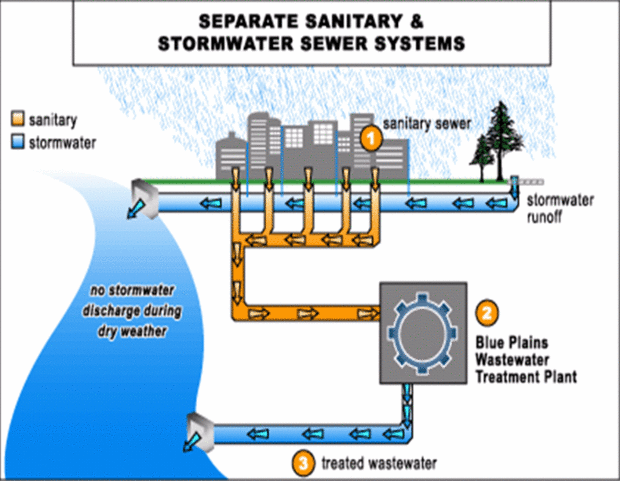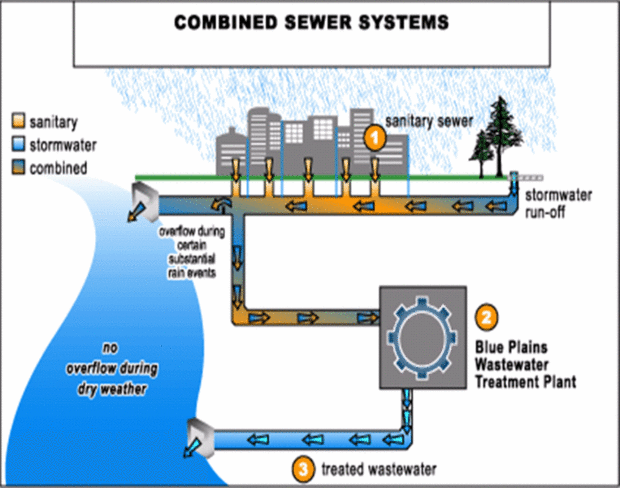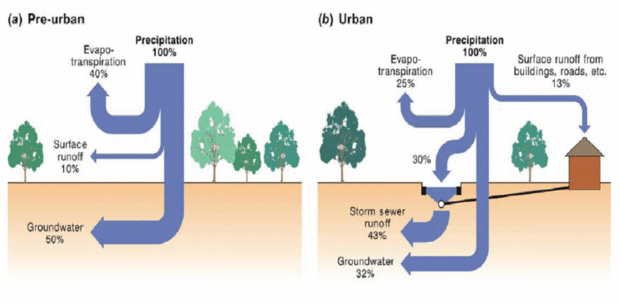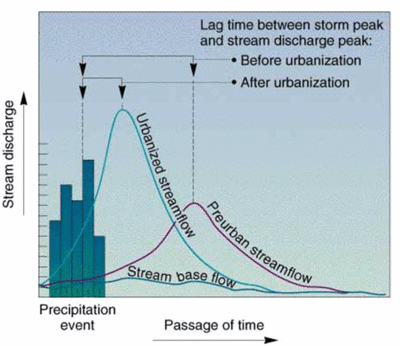Surface water management
| Topics: |
Contents
- 1 Introduction Surface water is precipitation that does not infiltrate into the ground or return to the atmosphere (Surface water management) by transpiration or evaporation. It may be loosely defined as water that stands or flows on the surface of the Earth and is commonly referred to as runoff. The management of surface water is a complex issue, mainly centered in historical precedent and practices, yet as knowledge increases on the unsustainable impacts of these traditional approaches to management, so does the need to challenge the current orthodoxy. This article briefly introduced the subject of surface water before outlining the main management challenges in more depth.
- 2 The problem of diffuse pollution
- 3 The problem of flooding
- 4 The problem of groundwater resources
- 5 The problem of economic development
- 6 Conclusion
- 7 Further Reading
Introduction Surface water is precipitation that does not infiltrate into the ground or return to the atmosphere (Surface water management) by transpiration or evaporation. It may be loosely defined as water that stands or flows on the surface of the Earth and is commonly referred to as runoff. The management of surface water is a complex issue, mainly centered in historical precedent and practices, yet as knowledge increases on the unsustainable impacts of these traditional approaches to management, so does the need to challenge the current orthodoxy. This article briefly introduced the subject of surface water before outlining the main management challenges in more depth.
Since the spread of urbanization associated with the change from an agrarian to industrial society, in developed countries we have drained our landscapes using essentially the same approach. Standing water is perceived as a hazard and therefore we have tried to move the runoff, or storm water, quickly, safely and economically into sewers, and then with the same emphasis into the nearest watercourse. However, urbanization changes the local natural hydrological cycle as the impermeable surfaces associated with development reduce infiltration and transpiration, and instead divert the precipitation into the drainage system. Figure 1 describes how the volume of surface runoff changes between natural and urbanized environments.
The problem of diffuse pollution
There are two main sources of pollution, point-source, such as the type that occurs from sewage and industrial effluent, and diffuse, which is the term given to pollution resulting from the combined problems of less quantifiable practices. Point source pollution is becoming more effectively regulated using the national and trans-national environmental protection legislation. Conversely however, as point source pollution has become more effectively controlled, the pollution arising from diffuse sources, such as surface water runoff, now has a proportionally greater effect on domestic watercourse quality and has been widely identified as the single biggest challenge to improving water quality. The effective management of diffuse pollution presents a significantly more complicated problem to solve than the traditional view of pollution. The principal challenge arises due to diffuse pollution effectively operating outside of many of our existing environmental protection mechanisms, making its recognition, reduction and subsequent monitoring a complex issue. On the whole, developed societies manage surface water by a storm water sewer system, a drainage method that separates runoff from sanitary treatment. This division however, helps to create problems of diffuse pollution, as it transports surface runoff into sewers and then into watercourses without any treatment. Consequently, effective management of diffuse pollution is unachievable using conventional drainage techniques (Fig. 2).
 Figure 2: A separate sewer system. (Source: DC Water and Sewer Authority)
Figure 2: A separate sewer system. (Source: DC Water and Sewer Authority) The separate sewer system does not attempt to manage problems of diffuse pollution as the ‘wash’ off roads and other surfaced areas conveys polluted debris into the storm water system and therefore untreated into the watercourse. In an urban area common pollutants include oils, metals, dog feces, etc., and outfalls that should discharge surface water have been found with average concentrations of suspended solids at a level equivalent to raw sewage. The problem is exacerbated as the build up of debris and pollutants on surfaces occurs at a steady rate and a storm provides the first ‘flush’ of an urban area, conveying diffuse pollution into the watercourse. This is even more concentrated after periods of dry weather. An additional concern is that there is no management of accidental spills using the separate system. For example, if oil is spilled by a car or industrial area the contaminant is simply washed with the rest of the untreated storm water into the watercourse. The mis-connection of foul sewage into surface water drains, such as by washing machines or dishwashers is also a surprisingly common problem.
Instead of a separate sewer system, in many older developments a combined sewer system may be in operation. This system, which was the forerunner to the separate system, also encounters many environmental problems, as all household wastewater and storm water is diverted into one combined sewer system where it is then transported to the treatment plant. This method may seem to be more environmentally friendly than the modern system, but during periods of significant rainfall the capacity of a combined sewer may be exceeded. When this occurs, regulators are designed to let the excess flow, which is a mixture of storm water and sanitary wastes, to be discharged untreated to the watercourse, causing pollution (Water pollution). This excess flow is called combined sewer overflow and is necessary to prevent flooding in property, businesses, and streets. Its magnitude may depend on factors such as rainfall intensity, or the volume of current and recent rainfall levels (Fig. 3).
 Figure 3: A combined sewer system. (Source: DC Water and Sewer Authority)
Figure 3: A combined sewer system. (Source: DC Water and Sewer Authority) In addition to problems of diffuse pollution, the way we manage water resources as a society can cause other forms of environmental damage. For example, traditional drainage techniques ensure that the flow levels of watercourses are tied quite closely to the rainfall levels in the immediate area, they may run either low or high in direct response to precipitation, and high, fast flows may wash away or damage riverside habitats, erode banks and deposit sediment. The process of flooding itself also brings direct environmental damage as sewer overflows and other forms of contaminant enter the watercourse, while the nearby flora and fauna are also detrimentally affected by the severe flows. The drainage orthodoxy underpinning the pollution of our watercourses means that despite advances in water quality in recent years, in many areas the rivers support little wildlife, reducing their amenity value.
The problem of flooding
The conventional drainage orthodoxy increases the potential for flooding, especially localized flash floods, due to the speed at which the runoff is conveyed. Although it should be noted that a small minority of drainage does incorporate devices to slow down drainage in urban areas, overall the strong emphasis is on moving the runoff from the urban area to the watercourse at high velocity, which causes a number of problems. Firstly, a watercourse of limited capacity is required to manage a potentially high volume of water from across the catchment within a relatively short period of time. If the precipitation is of a very intense nature this may result in the watercourse following its natural processes and utilizing its flood plain. These events are called flash floods and all things being equal are increasingly likely to occur as development and land use patterns distort the natural local hydrological cycle. Following major flooding episodes we have been warned that the threat of inland flooding will become increasingly common, as both the proposed development needs and the impact of climate change increase the possibility of future problems from rainfall. Furthermore, attention has also been drawn to the possibility that the built environment professions have exacerbated the social and economic impacts by allowing development to take place on flood plains and failing to exert an effective control over surface water. Figure 4 demonstrates the impact of urbanization on streamflow levels after a precipitation event, detailing how development can increase the risk of flooding by increasing both the volume and speed of runoff directed towards the watercourse.
In addition to problems of flash flooding, inundation of a more conventional nature may become more likely due to the current techniques of surface water management. Although time factors may place extra demands on a watercourse, issues of overall capacity become more prevalent as the additional runoff from new development is diverted into the watercourse. Furthermore, from a flooding perspective traditional land use controls focus heavily on spatial factors, such as the restriction of property within a flood plain and have only recently attempted to manage land use, runoff and flooding from a catchment-wide viewpoint. However, both the delayed recognition of the catchment-wide linkages and a lack of will and institutional capacity to implement many preventative measures, has meant that these recent efforts have as yet only had a peripheral impact. It should be noted however, that the rural sector has recognized that the management of land via watershed control or management is an option to increase the management of runoff, yet the problem of flooding is still exacerbated in some areas by certain intensive agricultural practices and land use management.
The emphasis on transporting the storm water at speed not only increases the potential for localized flash flooding, but also reduces the time available to issue effective flood warnings, and the time available for householders to take preventative measures. Flooding episodes can also have a serious lasting impact on the health of the householders affected, especially if sewage is involved. Health problems can include premature death, various clinical problems, drug and alcohol increase and treatment for depression. The costs of floods can also take on an intangible form through factors such as loss of confidence in authorities or a higher burden of long-term support, such as counseling for anxiety and stress.
The problem of groundwater resources
Urbanization also affects the hydrological cycle by restricting the volume of groundwater recharge, as the dominant drainage philosophy results in the level of infiltration being reduced as surface water, which may previously have infiltrated into the ground, is diverted to the sewer system. This process results in lower levels of groundwater storage, and can have significant negative effects on society, most noticeably perhaps by the increasingly regular summer drought. Indeed, if we take the case of the UK, despite its perception as a rainswept isle over the last 20 years three droughts have occurred that were expected to happen only once every 200 years, and perhaps surprisingly in world terms it is only ranked as a ‘low’ water availability country; the same as South Africa. Although annual rainfall in the UK is around 1125 millimeters (mm), an uneven distribution ensures that many areas receive significantly less rainfall than others. For example, the North West of England and North Wales averaged 1290 mm per year, while East Anglia received only 605 mm. Overall, groundwater provides more than 30% of the total public water supply (Society and water resources) with a much greater proportion required in southern and eastern England, due to both geology and high demand. Good supplies of groundwater are integral to both the nation’s drinking water area and a requirement of many ecological systems, yet with regard to groundwater resources many areas are experiencing problems of increasing demand and decreasing input, intensifying the need for more a sustainable management of surface runoff. On present trends it is unclear whether there will be sufficient water resources in the UK available beyond 2025 to meet demand.
Low groundwater resources can have serious environmental and economic effects and in many areas water is being abstracted at an unsustainable rate. This means that the demand for water from households and businesses is higher than the amount naturally recharged, leading to fears that the availability of water could inhibit future development needs and have a negative effect on many important wildlife sites. The present problem of over abstraction is made more serious by the predicted rise in water demand. Despite improved efficiency in water use, the public demand for more water is increasing and household water consumption per head has risen steadily. Pressures leading to an increasing demand for water include increased numbers of households, growing demand for non-essential uses of water (e.g. power showers, swimming pools), more garden watering and new commercial ventures. The lack of groundwater resources in some areas is exacerbated by the infrastructure used to transport and distribute water supplies. Leakages are a significant drain on resources and many water companies claim they are close to, or have already reached, their economic level of leakage reduction; yet in many areas the volume of losses is still high. Thames Water for example, which supplies London, annually loses enough water from leakages to supply 2.5 million people.
The problem of economic development
The conventional approach of managing surface water can also have a significant detrimental economic effect on society stemming from a number of related impacts. For example, conventional drainage practices create problems of diffuse pollution and therefore water treatment costs are higher for the water companies, which in turn results in higher water bills for consumers. While the problem of flooding results in the increased costs of both flood defense and channel clearing. Although the creation of effective flood defenses could have a positive economic impact on the area by acting as a spur to investment, if extra development does occur on the floodplain as a result of new defenses, the damage would be increased if flooding occurs. In addition, the building of more flood defenses create a cycle of expenditure as the overall long-term maintenance burden is raised, while it may also create a false sense of security and a decrease in personal preparation, which may lead to more damage if new flooding events happen.
The emphasis on transporting precipitation into the watercourse as quickly as possible also impacts on the insurance sector. Europe-wide floods in 2000 have damaged company profit levels and shareholder dividend. The increased perception of risk from flooding is now being reflected in both higher premiums and excess, as typical flood claims are increasing due to the more widespread usage of high-value electronic goods. In many countries, these costs are not just experienced by those living in houses at risk, as in practice either the government or the whole insurance market subsidizes the costs incurred by flooding. Where events causing damage become too frequent, high-value [[land use]s] may have to be shifted elsewhere in order to adapt to the threat of flooding.
The conventional drainage orthodoxy also brings considerable economic costs. Large, mostly unattractive culverts are expensive to build and maintain and present a danger to maintenance staff and children in times of rainfall. While gully pots require constant, expensive maintenance and are often blocked causing flooding and destroying wildlife by, for example, the trapping of newts and froglets. The prevalence of unattractive waterways also inhibits regeneration opportunities. The value (Value theory) of clean and valued urban waterways as a driver for development and regeneration is recognized, yet the drainage culture may inhibit development by underpinning diffuse pollution and advocating unsightly methods of transporting water. Regeneration opportunities can also be retarded by the impact of repeated flood events, which can sap the resources of the vulnerable communities affected. Furthermore, the damaging of watercourses affects wider society as in many of our cities, waterways are simply not exploited as a townscape feature, have barely any amenity value and support little wildlife.
Problems of limited capacity within the existing drainage network may also restrict development and regeneration opportunities. The extra runoff from new developments may mean that large and expensive sewers are required, whilst new development may actually be prevented in catchments already experiencing flood risk due to runoff problems. These factors, coupled with unsustainable water abstraction regimes and demand problems may affect the future location of developments, placing new burdens on strategic spatial development and the land use planning system.
Conclusion
This article is not designed to advocate that development and urbanization are damaging in themselves, but rather that we need to re-examine how we manage surface water as a society if we wish to limit the negative impacts. The current methodology of surface water management creates flooding and pollution, damages the environment, inhibits economic development and can cause significant social problems, yet only recently has there been a questioning of these practices. Although it is not the remit of this article to explore the possibility of implementing alternative drainage approaches, it should be recognized that there are different methods available, which could prevent or reduce the effect of a number of these undesirable impacts and so provide a more sustainable basis for surface water management. Sustainable drainage systems for example, have the potential to limit some of the impacts described previously while also providing a number of additional benefits, yet at present they are not widely used and the conventional drainage methodology continues to be the dominant philosophy.
The management of rainwater is a complicated issue as differing bodies may be responsible for surface water drainage dependent upon what is being drained and where to. In many areas, due to the nature of sewers rainwater has been managed as an incidental by water companies when managing sewage, rather than as an explicit task, and yet the nature of the impacts would suggest that the consideration of surface water issues should receive a higher recognition. Despite the perceived parallels between land use control and water quality control, the two areas have significant differences as they have been developed independently of each other. Yet, the unsustainable impacts experienced from rainfall appear to present a persuasive case for the re-examination of both the current management techniques and the regulations which sustain them. Moreover, the continuation of these problems indicates that to a large extent surface water management operates outside of conventional environmental control, thus making any reduction or mitigation of the impacts a considerable challenge.
The current drainage orthodoxy fails to address diffuse pollution, exacerbates problems of flooding and encourages lower groundwater resources. These problems present considerable challenges to a number of interrelated yet diverse fields, such as environmental protection, planning, regeneration and spatial development. The interdisciplinary nature of true flood and pollution prevention emphasizes that it would not only need to address the hydrological or land use management factors, but also the economic, social and political factors influencing wider society and underpinning their impact.
 Content Source: Wikimedia Commons
Content Source: Wikimedia Commons
Further Reading
- Construction Industry Research and Information Association, 2000. Sustainable Urban Drainage Systems—Design Manual for England and Wales. London, UK: Construction Industry Research and Information Association. ISBN: 0860175227
- Department for Environment, Food and Rural Affairs, 2002. Agriculture and water—a diffuse pollution review. London, UK: Department for Environment, Food and Rural Affairs.
- England and Wales Environment Agency
- Environment Agency, 2001. Lessons learned: Autumn 2000 floods. Bristol, UK: Environment Agency.
- Environment Agency, 2002. Water resources for the future - annual review. Bristol, UK: Environment Agency.
- Howe, J., and White, I., 2002. The geography of the autumn 2002 floods in the UK. Geography, 87(2):116–124.
- Parker, D. J., 2000. Floods. London, UK: Routledge. ISBN: 0415172381
- White, I. and Howe, J., 2004. The Mismanagement of Surface Water. Journal of Applied Geography, 24:261-280.

